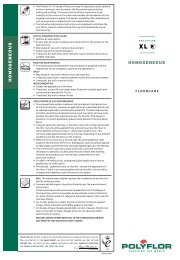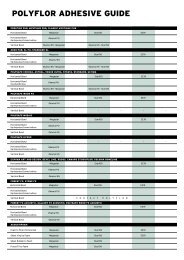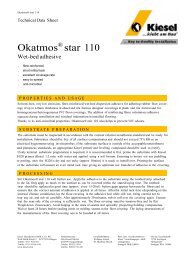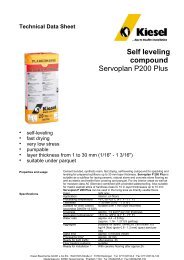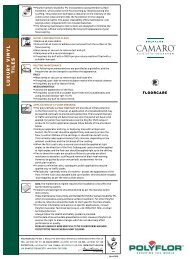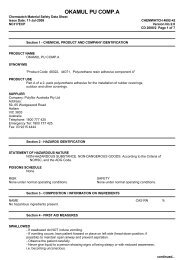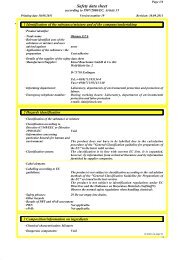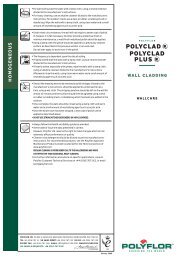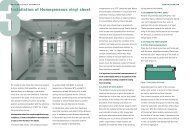Safety Solutions Brochure - Polyflor
Safety Solutions Brochure - Polyflor
Safety Solutions Brochure - Polyflor
You also want an ePaper? Increase the reach of your titles
YUMPU automatically turns print PDFs into web optimized ePapers that Google loves.
microroughness meter, can be used in-situ to risk<br />
assess the slip potential presented by pedestrian<br />
walkway surfaces. The software operator feeds in<br />
information on-site such as: the surface roughness<br />
readings, amount and causes of floor surface<br />
contamination, footwear used and the cleaning regime<br />
implemented in order to gain a slip risk classification for<br />
the floor. These factors are taken into account along<br />
with others detailed in the slip potential model. This<br />
simple software programme can be downloaded free of<br />
charge, from www.hse.gov.uk/slips.<br />
ROLLER-COASTER TEST - SLIP ALERT<br />
This is a relatively new measurement tool that has<br />
been developed specifically to reproduce the<br />
characteristics of the hydrodynamic squeeze film that<br />
occurs under a pedestrian’s heel when they slip,<br />
measuring the average slip resistance over the area<br />
tested. This involves a trolley rolling down a ramp and<br />
skidding across the floor surface. However, this test is<br />
in its infancy and with its limited experience, sole<br />
reliance to this test on manufacturers’ product<br />
specifications should not be sought to qualify<br />
specification of floor surfaces.<br />
RIBA APPROVED CPD<br />
A RIBA Approved CPD Seminar is available to be<br />
presented by a <strong>Polyflor</strong> representative covering the<br />
afore-mentioned slip resistance test methods and to<br />
assist in the specification of safety floorcoverings.<br />
Contact <strong>Polyflor</strong> for further information. This<br />
presentation is also available as an online CPD. Further<br />
details can be found by visiting www.ribaonlinecpd.com.<br />
EN 13845:2005<br />
This European Norm specifically relates to<br />
particle based safety flooring. Whilst this<br />
standard covers all aspects of product quality,<br />
it also brings in another measure of slip resistance:<br />
ESf – all Polysafe products achieve a rating of<br />
Enhanced Slip for use with footwear, as opposed to DS,<br />
(meaning Dry Slip) as stated in the EN 13893 standard.<br />
ESb – Polysafe Hydro achieves a rating of Enhanced<br />
Slip Barefoot.<br />
CE MARKING<br />
From 2007, all flooring sold in Europe must have carried<br />
the CE mark and show results on two mandatory<br />
performance aspects – fire and slip.<br />
The vast majority of smooth vinyl floors will<br />
carry a Dry Slip rating – this essentially means that the<br />
flooring is safe for use. For safety flooring or slip<br />
resistant flooring specifically, you should look for an<br />
ES rating.<br />
In addition, continually wet area safety floorings like<br />
Polysafe Hydro must conform to EN 13553 for water<br />
tightness, in order to achieve CE marking status.<br />
Points to consider:<br />
• HSE recommends the Pendulum test in conjunction<br />
with surface microroughness meter for real life in-situ<br />
results<br />
• All Polysafe products adhere to HSE Guidelines,<br />
achieving 36+ in the Pendulum wet test (Four S Rubber<br />
/Slider 96) with a surface roughness of Rz ≥20µm.<br />
• The slip resistance on all Polysafe ranges is assured for<br />
the guaranteed life of the product<br />
• Other methods of measuring slip resistance are only<br />
complementary and should not be used as sole<br />
indicators for specification. For example, the Ramp test<br />
is an ex-factory test and cannot be replicated on-site<br />
• RIBA Approved CPD seminar for the specification of<br />
safety vinyl floorcoverings is available directly from<br />
<strong>Polyflor</strong> representatives or online<br />
USEFUL REFERENCES FOR FURTHER READING<br />
‘Assessing the slip resistance of flooring’ HSE Information Sheet, 2007<br />
‘Taking Slips and Trips Seriously’ Paul Beaumont, HSC<br />
‘Slips and trips: The importance of floor cleaning’<br />
HSE Information Sheet – Slips and Trips 2<br />
‘Slips and trips: Summary guidance for the catering industry’<br />
HSE Information Sheet – Catering Sheet No 6<br />
‘Preventing slips in the food and drink industries – technical update on<br />
floor specifications’ HSE Information Sheet – Food Sheet No 22<br />
‘Preventing slips and trips in kitchens and food service’<br />
HSE Information Sheet – Catering Sheet No 6 (revised)<br />
‘Preventing slip and trip incidents in the education sector’<br />
HSE Information Sheet – Education Sheet No 2 (revised)<br />
‘Slips and trips in the health services’ HSE Information Sheet –<br />
Health Services Sheet No 2<br />
UK Slip Resistance Group (UKSRG) Guidelines, 2005<br />
Health Technical Memorandum 61 : Flooring – Department of Health<br />
All HSE Guidance is available on: www.hse.gov.uk/slips/information.htm<br />
33




